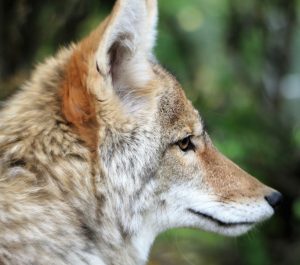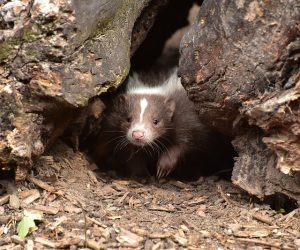Love them or not, urban wildlife are here. While humans develop land for our own needs, we’re finding ourselves living closer to animals who are finding themselves with less habitat and adapting to ours. As such, human/wildlife conflicts emerge– though there are many things we can do to prevent it!
If You Find Sick, Injured, or Abandoned Wildlife
- In most cases, leave the animal alone. Contact us at HSHV or an appropriate agency (e.g., Friends of Wildlife, Help 4 Wildlife, or Bird Center of Washtenaw County) for advice.
- Never offer ANY food or liquid (including milk and water) to the animal without first consulting an expert.
- If the animal appears to be an abandoned baby in immediate danger, it is okay to place it in a dark, warm, quiet place while you wait for advice from Emergency Rescue staff or wildlife rehabilitator.
- To keep the animal warm, follow these instructions for kittens, or these instructions for other animals.
- Remember, it is illegal to keep/rehabilitate wildlife unless you are a certified wildlife rehabilitator. While you may mean well, animals that are rehabilitated without the knowledge of a certified wildlife rehabilitator will not survive when released back into the wild.
- If it’s an adult deer that’s been hit by a car, please call both us (734) 661-3512 and the Washtenaw County Sheriff’s Office non-emergency dispatch (734) 994-2911.
Does the animal need help?
NEVER remove an animal from their natural habitat, nest, or burrow without consulting professionals first!
- An uninjured young animal(s) is found in the woods, garden, or yard (many species will leave their babies temporarily to keep them safe while the parents go find food)
- Young animals are almost never truly abandoned.
- Birds that aren’t flying away and appear uninjured DO NOT need help. Young birds that are learning to fly often take breaks on the ground to rest; please leave them alone.
- If there is a fawn lying in your yard or in the woods, s/he DOES NOT need help; mothers will leave them alone (sometimes for up to 10-15 hours) to keep them safe from predators, as fawns do not have a scent at that age. Interacting with a fawn can leave your scent on it, potentially attracting predators.
- Has a visible wound or is actively bleeding.
- Is unable to move properly (limping, limbs being held in a strange position, unable to fly in the case of birds).
- Is exhibiting unusual behavior (lethargic, unresponsive, appears confused).
- Is a young animal alone (or if there is a dead parent nearby) and in immediate danger (on or near a roadway, inside a building, etc.) or is vocalizing excessively.
If you encounter a wild animal exhibiting any of these signs, it’s important to contact your local humane society, wildlife rehabilitation center, or veterinarian for advice on the best course of action. Avoid handling the animal yourself unless absolutely necessary, as it can be dangerous for both you and the animal, particularly when an animal is distressed. Always prioritize professional assistance to ensure the animal receives the appropriate care.
Please contact HSHV first at (734) 661-3512 if the animal is in Washtenaw County. If an adult deer has been hit by a car, please also contact the Washtenaw County Sheriff’s Office non-emergency dispatch at (734) 994-2911.
I Found a Baby Animal… Now What?
Babies ALWAYS have a better chance of survival if they can be reunited with their mother. Despite the great work wildlife rehabilitators do, it does not replicate the care a mother animal can provide. Please DO NOT give an animal any food or water unless specifically instructed by a professional. If you must handle a wild animal, please use protective gloves.
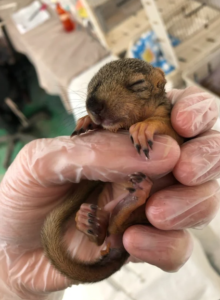
Does the baby squirrel have open eyes?
- YES, does the baby squirrel have a fluffy tail and a body longer than 6 inches?
-
- YES, please leave the baby alone, it is at an age where it is now independent.
- NO, place the baby in a container lined with tissues or soft cloth and place it in the tree where it was found for the mother to come back for. If it is still there after a couple hours, please contact your local humane society or veterinarian.
-
- NO, if the baby is not warm to the touch, warm it with your hands, and then place the baby in a container lined with tissues or soft cloth and place it in the tree where it was found for the mother to come back for. If it is still there after a couple hours, please contact your local humane society or veterinarian.
Is the fawn lying upright or curled up in a circle and remaining still and quiet?
- YES, please leave the fawn alone. The mother is nearby and will come back.
- NO, if the fawn is lying on their side, crying out, running around, or has a visible injury, please contact your local humane society or veterinarian.
Is the baby raccoon healthy and uninjured? Signs of illness may include discharge from eyes or nose, lethargy, appearing emaciated (highly visible rib cage), being covered in fleas or other parasites or eggs/larvae.
- YES, place the baby raccoon in a container lined with cloth or soft tissue and leave it near where it was found around dusk for the mother to come back for. If it is still there after a couple hours, please contact your local humane society or veterinarian.
- NO, please contact your local humane society or veterinarian.
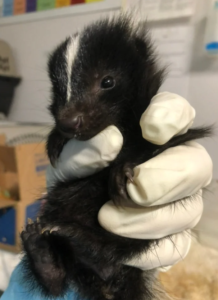
Is the baby skunk healthy and uninjured? Signs of illness may include discharge from eyes or nose, lethargy, appearing emaciated (highly visible rib cage), being covered in fleas or other parasites or eggs/larvae.
- YES, please leave it alone. Young skunks are very adventurous and will explore on their own. If you still see it alone with no mother after several hours, please contact your local humane society or veterinarian.
- NO, please contact your local humane society or veterinarian.
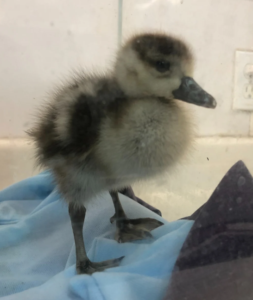
Does the baby animal have a layer of fluffy, soft, down feathers?
- YES, if the animal appears healthy and alert and there are more members of the same species nearby, try to unite it with the others. Make sure you give the animals space after moving them closer together. If it is visibly injured or is lethargic, please contact your local humane society or veterinarian.
- NO, the animal is a juvenile and is able to take care of itself. As long as the animal appears healthy and alert, the animal will be perfectly fine on its own. If it is visibly injured or is lethargic, please contact your local humane society or veterinarian.
Does the baby bird have feathers?
- YES, this bird is a fledgling. It is normal for fledglings to be out of the nest while learning to fly. The parents are still actively taking care of it so it can be left alone. If it is visibly injured or is lethargic, please contact your local humane society or veterinarian.
- PARTIALLY, this bird is a nestling. If the nestling is not alert and opening its mouth for food, please contact your local humane society or veterinarian.
- If the nestling is alert and opening its mouth for food, return it to the nest, if possible. If you can’t find it, place the hatchling in a cloth-lined box in the branches of the nearest tree to where you found it. If it is still there after a couple hours, contact your local humane society or veterinarian.
- NO, this bird is a hatchling. If the animal is not warm to the touch, please contact your local humane society or veterinarian.
- If the hatchling is warm to the touch, return it to the nest, if possible. If you can’t find it, place the hatchling in a cloth-lined box in the branches of the nearest tree to where you found it. If it is still there after a couple hours, contact your local humane society or veterinarian.
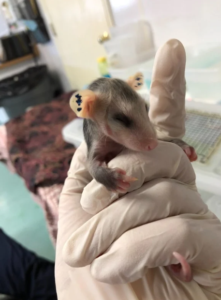
Is the baby opossum smaller than 5 inches long (not including the tail)?
- YES, the mother has likely lost that baby. Opossums will carry up to 13 babies at once,
with many not surviving to adulthood. Mothers will not return for lost babies. Please
contact your local humane society or veterinarian. - NO, if the animal does not have a visible injury, please leave the animal alone.
Wildlife Rescue
Our partnership with wildlife rehabilitators has saved thousands of lives. If you have a general question or would like information on wildlife, these agencies are excellent resources:
And HSUS (no relation to HSHV) has lots of great information on orphaned and injured wild baby animals as well.
Humane Wildlife Removal Service
Need an unwanted intruder evicted from your home or garage and want it done with compassion and skill, without causing the animal injury or unnecessary harm? HSHV offers Humane Wildlife Removal Services for Washtenaw County residents. Let us help you resolve your wildlife conflict with compassion and know-how. Our rates are extremely affordable and our care is truly humane. Plus, every cent goes back to help homeless, injured and abused animals!
Call us for a consultation today: (734) 661-3512
Please leave a detailed message including your phone number, the problem you are having, your location (city and street) and the best time to reach you. Your phone call will be returned by one of our professional team members. Services are available between the hours of 8 am to 9 pm April 1 through September 30, and from 8 am to 7 pm October 1 through March 31. Please note: Spring, summer, and sometimes fall can be extremely busy for our rescue department. Injured and orphaned animals come first, so we regret we may not always be available right away.
Services Available
- Guidance and education for humanely deterring animals away from residences (See also HSUS. HSUS is not related to HSHV)
- Deceased domestic animal pick-up (We regret we cannot pick up deceased wildlife)
- Humane removal (using humane methods and live-traps) and release onsite of the following animals:
- Raccoons
- Opossums
- Skunks
- Woodchucks/Groundhogs
- Squirrels
- Birds
- Snakes
- Bats (Single bats only; we do not do colonies. Please contact the health department at 734-544-6700 first if you or someone else has been exposed to a bat.)
- For feral cats, please contact our Community Cat Coordinator to discuss Trap, Neuter, Vaccinate and Return options at tnr@hshv.org or (734) 661-3523.
Please note: We do not remove animals from yards.
Our Basic Fees
- $100 for consultation and immediate animal removal ($45 for each additional animal)
- $35 extra will be charged for set-up and removal of a humane live trap.
Sorry, we cannot provide:
- Animal proofing or repairs to buildings or lawns
- Clean-up of animal waste or odor removal
- Insect removal or application of repellents of any kind
- Removal of nuisance mice, rats, or moles, chipmunks, foxes, geese, deer, or rabbits (But click on the links for ideas and help)
- Removal of animals off your property line, due to legal regulations
- Removal of deceased wildlife animals
- Assistance outside of Washtenaw County
Tips on Living with Wildlife
Groundhogs
 Groundhogs spend most of their time trying to consume sufficient food in order to have enough fat to survive hibernation, and they are attracted to areas where they can find food and feel safe. While they may be considered a pest to gardeners and homeowners, groundhogs are in fact very gentle and often just looking for their next meal. They don’t wander far from their den openings, so by deterring them from living in your yard you can greatly reduce the chances of them wandering through.
Groundhogs spend most of their time trying to consume sufficient food in order to have enough fat to survive hibernation, and they are attracted to areas where they can find food and feel safe. While they may be considered a pest to gardeners and homeowners, groundhogs are in fact very gentle and often just looking for their next meal. They don’t wander far from their den openings, so by deterring them from living in your yard you can greatly reduce the chances of them wandering through.
Worried about groundhogs building burrows in your lawn? These solitary creatures enjoy living in transitional areas like the edge of a field or in a prairie next to a forest. If you keep debris such as loose stones, woodpiles or compost piles cleaned up then groundhogs feel exposed and are significantly less likely to live in your yard.
To help deter groundhogs from coming near your home or garden try implementing these strategies:
- Remove any woodpiles, loose stones or groundcover from the area to deter them
- Place used cat litter around groundhog burrows; they will feel like predators are in the area and not want to live there
- Place shiny plastic strips or other shiny items like old cd’s near burrow entrances. This will make groundhogs feel like predators are around.
- Put up fencing around your home, porch or garden. Remember to bury it at least 8-12 inches down and then another 10 inches away from the structure in an L shape.
Chimney Swifts
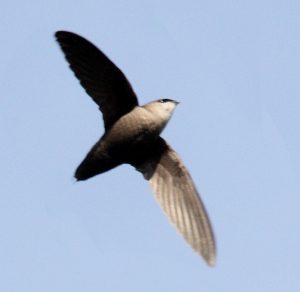 It’s a flying cigar… it’s a plane… it’s a chimney swift! As their name implies these migratory birds often make their nests in uncapped chimneys. Before the advent of European settlers to North America they would build nests in hollow trees and caves.
It’s a flying cigar… it’s a plane… it’s a chimney swift! As their name implies these migratory birds often make their nests in uncapped chimneys. Before the advent of European settlers to North America they would build nests in hollow trees and caves.
Want to keep your chimney free and clear of unwanted nest materials? All you have to do is put a cap on your chimney during the winter months when the chimney swifts have migrated south. That way you ensure there are no young birds caught in your chimney. If you would like to help the chimney swifts find an alternative nesting site you can building a nesting tower. Here are some plans to get you started!
To help deter chimney swifts from nesting in your home, try this strategy:
- Cap your chimney in the winter.
Mute Swans
 Not native to the United States, mute swans were originally brought the North America to decorate the ponds and lakes of large estates and parks. The mute swan population has expanded over the years and they can now be found across the U.S. It is not legal to hunt mute swans in Michigan.
Not native to the United States, mute swans were originally brought the North America to decorate the ponds and lakes of large estates and parks. The mute swan population has expanded over the years and they can now be found across the U.S. It is not legal to hunt mute swans in Michigan.
Mute swans are not likely to cause conflicts with people, but some people are concerned about their perceived aggressiveness. Mute swans are known to be very protective of their nests, especially if a female swan is incubating her eggs. To prevent conflict simply avoid approaching swans, especially if they are nesting or with their cygnets (babies). To further prevent conflict with mute swans you may try:
- Use mild pestering, such as putting up a scarecrow or using Mylar tape, to make your property uninviting.
- Certain repellents may be sprayed on grass to make it undesirable as a food source.
Trumpeter Swans
 These elegant birds with snowy white feathers are a protected species in Michigan. It is not legal to hunt or harass trumpeter swans. Trumpeter swans can be distinguished from mute swans by their black beaks, as opposed to mute swans’ orange bill.
These elegant birds with snowy white feathers are a protected species in Michigan. It is not legal to hunt or harass trumpeter swans. Trumpeter swans can be distinguished from mute swans by their black beaks, as opposed to mute swans’ orange bill.
Trumpeter swans are not likely to cause conflicts with people, but some people are concerned about their perceived aggressiveness. Trumpeter swans are known to form strong familial bonds and are very protective of their nests, especially if a female swan is incubating her eggs. To prevent conflict simply avoid approaching swans, especially if they are nesting or with their cygnets (babies). To further prevent conflict with trumpeter swans you may try:
- Use mild pestering, such as putting up a scarecrow or using Mylar tape, to make your property uninviting.
- Certain repellents may be sprayed on grass to make it undesirable as a food source.
Squirrels
 Whether you live in the city, country or somewhere in-between you’re likely to have crossed paths with a squirrel. Some species of squirrel, like the fox squirrel, have actually learned to thrive amongst human populations. For the most part, squirrels and humans can exist side-by-side without conflict, but occasionally undesirable situations can arise.
Whether you live in the city, country or somewhere in-between you’re likely to have crossed paths with a squirrel. Some species of squirrel, like the fox squirrel, have actually learned to thrive amongst human populations. For the most part, squirrels and humans can exist side-by-side without conflict, but occasionally undesirable situations can arise.
Some people are put off by squirrels raiding bird feeders. Fortunately, there are many bird feeders on the market these days that prevent squirrels from being able to reach the food in bird feeders. If squirrels emptying the bird feeder is a problem, you could also consider only filling your bird feeder with foods that appeal to birds but not squirrels, such as white millet seed, Niger thistle and safflower seed.
To further prevent conflicts with squirrels, consider the following:
- Close off small openings to attics and chimneys
- Purchase bird feeders that do not allow squirrels access to food
- Continue to keep garbage secured in bins that do not allow wildlife access
Raccoons
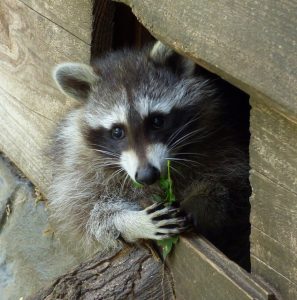 These bandit-masked animals are believed to be just as intelligent as cats and dogs. Because they are also highly dexterous and resourceful some people find themselves in opposition to these clever animals. While raccoons used to only be found in forests they have learned to adapt to living in urban and suburban environments as their natural habitats have been destroyed. Raccoons love to seize an easy opportunity, so unsecured garbage bins and accessible pet food encourage raccoon visitors. Similarly, small openings that allow access to attics, chimneys or garages are appealing to raccoons looking for a den.
These bandit-masked animals are believed to be just as intelligent as cats and dogs. Because they are also highly dexterous and resourceful some people find themselves in opposition to these clever animals. While raccoons used to only be found in forests they have learned to adapt to living in urban and suburban environments as their natural habitats have been destroyed. Raccoons love to seize an easy opportunity, so unsecured garbage bins and accessible pet food encourage raccoon visitors. Similarly, small openings that allow access to attics, chimneys or garages are appealing to raccoons looking for a den.
Raccoons generally do not pose a threat to humans, but can cause damage to property. The easiest way to avoid conflict with raccoons is prevention! Follow these tips to avoid potential raccoon problems:
- Refrain from leaving any pet foot outside overnight
- Continue to keep garbage secured in bins that do not allow wildlife access
- Secure pet doors and close off small openings to attics and chimneys
- Make your home space less appealing to raccoons with mild harassment such as bright lights or loud music
- Place fences around gardens
Coyotes
See a presentation on Coexisting with Coyotes (June 2025) here.
Though coyotes originally only lived in the grasslands of the western United States and Canada, they can now be found across the United States. These adaptive animals have long been persecuted because of their reputation as livestock predators. Those living in urban/suburban settings are more likely to be concerned for the safety of their companion animals. While coyotes are predators who eat smaller animals, they are generally wary of humans and will avoid preying on animals who are accompanied by their human companions.
If you are concerned about your own pet’s safety, you need not worry much! You can easily protect your companion animal by accompanying them while outside. This is especially true at night, as coyotes are nocturnal animals. Free roaming cats are the most likely domestic animals to be victims of coyotes, so cats should be kept indoors as much as possible. If that is not feasible, it is important to make sure cats have a vertical space where they can escape (a tree, a tall wooden post, etc.)
To coexist peacefully with coyotes, try implementing these strategies:
- Refrain from leaving any pet foot outside overnight
- Continue to keep garbage secured in bins that do not allow wildlife access
- Accompany companion animals while outdoors
- If you encounter a bold coyote who is active during the day and/or does not seem intimidated by human presence it is important to get across the message that you are a threat. This can be done without harming the coyote by shouting, banging loud objects or spraying them with a hose.
Skunks
A gentle creature with many beneficial behaviors, skunks can be unnecessarily feared by humans because of their pungent smelling spray. Skunks are not aggressive in nature and will rarely bother humans. Because their eyes don’t clearly define what is in front of them, it may appear that they are approaching humans when in fact, they are harmlessly walking about in search of food. Munching mostly on small rodents, insects and grubs, skunks are great at natural pest control and tend to enjoy the critters that many humans don’t.
Fearful of being sprayed? When a skunk is feeling threatened, he/she will give several warning signs before spraying. These include stomping their front feet, lifting their tail and hissing. It is when humans or our unleashed pets don’t heed their warnings that these docile animals feel the need to further protect themselves and use their powerful spray. If you come across a skunk, moving away slowly and quietly will help ensure that a skunk will keep their spray to themselves.
To help deter skunks from coming near your home, try implementing these strategies:
- Refrain from leaving any pet foot outside overnight
- Keep dogs leashed or in a fenced area at all times, especially at night
- Place a seed tray under bird feeders to prevent seeds from falling to the ground, which can attract some wildlife
- Continue to keep garbage secured in bins that do not allow wildlife access
- Block off any openings under decks, porches or sheds
- Secure all outbuildings to prevent skunks from wandering into them
Opossums
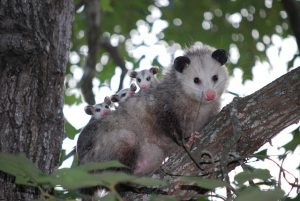 Myths abound about these helpful and misunderstood creatures. Opossums may have a scary look but they are actually quite gentle and have some very beneficial behaviors. They eat ticks and can’t get rabies or many other illnesses due to their low body temperature.
Myths abound about these helpful and misunderstood creatures. Opossums may have a scary look but they are actually quite gentle and have some very beneficial behaviors. They eat ticks and can’t get rabies or many other illnesses due to their low body temperature.
Opossums will keep to themselves and are transient, often spending most of their time wandering around looking for food. While they are mostly nocturnal, it is not unusual to spot one during the day. They may wander into your yard, but they won’t stay for long.
The best thing to do if you spot an opossum in your yard is to wait them out; chances are they will move along soon. You can also:
- Keep garbage secured in bins that do not allow wildlife access
- Block off any openings under decks, porches or sheds





